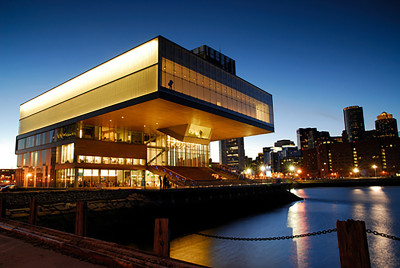
In the early 1930s, educator John Rice founded a small, experimental liberal arts college near Asheville, North Carolina. The name of the school was Black Mountain College, and its mission was to educate young artists and thinkers in a radical, interdisciplinary way. Though the college only existed for 24 brief years due to financial struggles, many of the most influential figures in modern American art passed through its halls as both educators and students.
To pay homage to BMC and educate the public about the school’s myriad contributions to the art world, the Institute of Contemporary Art in Boston has undertaken its most ambitious curatorial project to date — an exhibit titled “Leap Before You Look: Black Mountain College 1933-1957.”
The exhibition, which opened Saturday, will be open until January 2016, when it will move to the Hammer Museum in Los Angeles, California. “Leap Before You Look” is the United States’ first retrospective exhibition dedicated to the college. Many, including art professors in the Boston area, believe it is a long overdue look at one of the country’s most influential art schools.
“This is the first comprehensive and nuanced look at the college,” said Gloria Sutton, a professor of art history at Northeastern University. “We are looking at why this utopian model continues to be evoked in modern art.”
Sutton said that she is organizing a symposium in conjunction with the ICA that invites a panel of artists, scholars and curators to discuss the college’s impact on art. Her symposium, which will be one of the many forums and lectures related to the exhibition, is part of a larger initiative to engage the community in a dialogue about modern art and to reflect the informal discussion-based approach to education that defined BMC.
The exhibition itself features 261 objects by nearly 100 artists, a grand piano and a dance floor for in-house performances. The show boasts an impressive and varied collection of works by Josef and Anni Albers, Willem de Kooning and Robert Rauschenberg. The show also features jewelry by Alexander Reed.
Dance, performance and music also play a prominent role in the exhibition. To reflect the interdisciplinary approach BMC took toward art education, the ICA will feature an almost constant series of performances, many of which occur alongside the tangible art.
“A lot of the performances take place in the gallery space,” said Annie Narrigan, one of the gallery’s supervisors. “We want to reflect the Black Mountain approach in that way.”
“Leap Before You Look” also features an array of never-before-seen photographs of the college.
“What’s different about this show is that we have a lot of archival material and a lot of it is new,” Narrigan said. “The curators actually went to Asheville to look through the college’s archives.”
The archived materials, many of which are photographs of subjects on campus, are on prominent display when visitors enter the gallery space. The photos hang alongside a brief biography and timeline of the college in the entrance of the gallery.
Inside, the somewhat modest space overflows with famous and some not-so-famous works by artists associated with the college. The walls are heavy with groundbreaking work and the floor is peppered with innovative sculptures and installations.
The kind of music that would have been practiced and performed at the College, such as Bach, Mozart, Beethoven, Ellington and Schoenberg, plays as visitors explore the gallery.
A performance space graces the middle of the gallery. A grand piano is flanked by compositions that are performed periodically. The adjacent dance floor is available for performances that will run throughout the exhibition.
Silas Reiner, a former member of the Merce Cunningham Dance Company that was initially formed at BMC, directed students from Harvard University and the Boston Conservatory over the long weekend and Tuesday in dances inspired by Cunningham’s choreography.
The innovative and complex exhibition attracted approximately 1,000 visitors over its opening weekend, including three BMC alumni and a multitude of scholars and professors.
“We are really encouraging people to come back,” Narrigan said. “Their experience will be different every time.”




